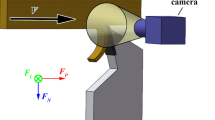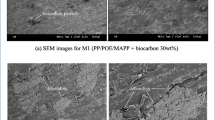Abstract
Metal oxide reinforced composite, as a new kind of engineering material, was an essential research topic to industry. Magnesium oxide as particle-reinforced phase, were mixed with wood fiber-matrix to enhance the mechanical properties of composite. However, the research on the surface quality of this composite is still desirable for expanding its application. In order to investigate the surface integrity of this kind particle-reinforced wood-based composite, spiral up-milling experiments were performed with different cutting depth and cutting speed. The effect of cutting speed and cutting depth on surface integrity was investigated. According to the calculation results of black pixels proportion of binary image of machined surface, surface defects were greatly affected by cutting depth rather than cutting speed. Defects, such as pile-up and debonding of particles, were usually observed under 0.5 mm cutting depth, meanwhile, extensive damage of flacking and fracture of wood fiber-matrix were usually observed under 1.5 mm cutting depth. In all, the machined surface formation mechanism of this composite can be different by changing cutting depth.










Similar content being viewed by others
Availability of data and materials
The datasets generated and analysed during the current study are available from the corresponding author on reasonable request.
References
Kilinc, K., Kanbur, Y., & Tayfun, U. (2019). Mechanical, thermo-mechanical and water uptake performance of wood flour filled polyurethane elastomer eco-composites: Influence of surface treatment of wood flour. Holzforschung, 73, 401–407.
Huang, L. L., Wang, H. Y., Guo, X. L., Jiang, Z. H., Xing, F., Huang, L. L., & Ekevad, M. (2018). Study on continuous cold-pressing technology of engineered wood flooring with EPI adhesive. Wood Res-Slovakia, 63, 335–342.
Bazant, P., Munster, L., Machovsky, M., Sedlak, J., Pastorek, M., Kozakova, Z., & Kuritka, I. (2014). Wood flour modified by hierarchical Ag/ZnO as potential filler, for wood-plastic composites with enhanced surface antibacterial performance. Industrial Crops and Products, 62, 179–187.
Pelaez-Samaniego, M. R., Yadama, V., Lowell, E., & Espinoza-Herrera, R. (2013). A review of wood thermal pretreatments to improve wood composite properties. Wood Science and Technology., 47, 1285–1319.
Lin, Z. Y., & Renneckar, S. (2011). Nanocomposite-based lignocellulosic fibers 2: Layer-by-layer modification of wood fibers for reinforcement in thermoplastic composites. Composites Part A: Applied Science and Manufacturing, 42, 84–91.
Fowler, P. A., Hughes, J. M., & Elias, R. M. (2006). Biocomposites: Technology, environmental credentials and market forces. Journal of the Science of Food and Agriculture, 86, 1781–1789.
Guo, X., Lin, Y., Na, B., Liang, X., Ekevad, M., Ji, F., & Huang, L. (2016). Evaluation of physical and mechanical properties of fiber-reinforced poplar scrimber. BioResources. https://doi.org/10.15376/biores.12.1.43-55
Guo, X., Wang, H., Chen, Q., Na, B., Huang, L., & Xing, F. (2017). The dimensional stability of engineered wood flooring in heating systems. Wood Res-Slovakia, 62, 103–111.
Bai, W., Roy, A., Sun, R., & Silberschmidt, V. V. (2019). Enhanced machinability of SiC-reinforced metal-matrix composite with hybrid turning. Journal of Materials Processing Technology, 268, 149–161. https://doi.org/10.1016/j.jmatprotec.2019.01.017
Chawla, N., & Shen, Y. L. (2001). Mechanical behavior of particle reinforced metal matrix composites. Advanced Engineering Materials, 3, 357–370.
Hung, N. P., Boey, F. Y. C., Khor, K. A., Oh, C. A., & Lee, H. F. (1995). Machinability of cast and powder-formed aluminum alloys reinforced with SiC particles. Journal of Materials Processing Technology, 48, 291–297. https://doi.org/10.1016/0924-0136(94)01661-J
Yanming, Q., & Zehua, Z. (2000). Tool wear and its mechanism for cutting SiC particle-reinforced aluminium matrix composites. Journal of Materials Processing Technology, 100, 194–199. https://doi.org/10.1016/S0924-0136(99)00405-7
Ding, X., Liew, W. Y. H., & Liu, X. D. (2005). Evaluation of machining performance of MMC with PCBN and PCD tools. Wear, 259, 1225–1234.
Sasimurugan, T., & Palanikumar, K. (2011). Analysis of the machining characteristics on surface roughness of a hybrid aluminium metal matrix composite (Al6061-SiC-Al2O3). Journal of Minerals and Materials Characterization and Engineering, 10, 1213–1224. https://doi.org/10.4236/jmmce.2011.1013094
Ge, Y., Xu, J., & Fu, Y. (2011). Experimental study on high-speed milling of SiCp/Al composites. Materials Processing Technology, 291, 725.
Yu, W., Chen, J., Ming, W., An, Q., & Chen, M. (2021). Experimental and FEM study of cutting mechanism and damage behavior of ceramic particles in orthogonal cutting SiCp/Al composites. Ceramics International, 47, 7183–7194. https://doi.org/10.1016/j.ceramint.2020.11.072
Bhushan, R. K., Kumar, S., & Das, S. (2010). Effect of machining parameters on surface roughness and tool wear for 7075 Al alloy SiC composite. The International Journal of Advanced Manufacturing Technology, 50, 459–469. https://doi.org/10.1007/s00170-010-2529-2
Li, R. R., Xu, W., Wang, X. D., & Wang, C. G. (2018). Modeling and predicting of the color changes of wood surface during CO2 laser modification. Journal of Cleaner Production, 183, 818–823.
Li, W. G., Zhang, Z. K., Peng, X. R., & Li, B. (2017). The influences of circular saws with sawteeth of mic-zero-degree radial clearance angles on surface roughness in wood rip sawing. Annals of Forest Science, 74, 1–9.
Dong, G. J., Zhang, Y. J., Zhou, M., & Wang, Y. J. (2014). The research of effect of cutting parameters on machined surface defects in high-speed milling of SiCp/Al composites. Key Engineering Materials, 589, 245. https://doi.org/10.4028/www.scientific.net/KEM.589-590.245
Wang, T., Xie, L. J., Wang, X. B., Jiao, L., Shen, J. W., Xu, H., & Nie, F. M. (2013). Surface integrity of high speed milling of Al/SiC/65p aluminum matrix composites. Procedia Cirp, 8, 475–480. https://doi.org/10.1016/j.procir.2013.06.136
Ramanujam, R., Muthukrishnan, N., & Raju, R. (2011). Optimization of cutting parameters for turning Al-SiC(10p) MMC using ANOVA and grey relational analysis. International Journal of Precision Engineering and Manufacturing. https://doi.org/10.1007/s12541-011-0084-x
Michalska-Pożoga, I., Tomkowski, R., Rydzkowski, T., & Thakur, V. K. (2016). Towards the usage of image analysis technique to measure particles size and composition in wood-polymer composites. Industrial Crops and Products, 92, 149–156. https://doi.org/10.1016/j.indcrop.2016.08.005
Guo, X., Wang, J., Buck, D., Zhu, Z., & Guo, Y. (2021). Machinability of wood fiber/polyethylene composite during orthogonal cutting. Wood Science and Technology. https://doi.org/10.1007/s00226-020-01256-4
Acknowledgements
This work is a Project Funded by the National First-class Disciplines (PNFD). The authors are grateful for the support from the National Science Foundation of China (31971594), Leitz Tooling System Co. Ltd. for supplying the samples of PCD tools, and Guofeng Wood Plastic Composite Co. Ltd. for supplying the samples of wood fiber/polyethylene composite.
Funding
This work is a Project Funded by the National First-class Disciplines (PNFD). The authors are grateful for the support from the National Science Foundation of China (31971594).
Author information
Authors and Affiliations
Contributions
JW: laboratory experiment, data collection, analysis and discussion of the data, and editing the paper. RJ: project administration, experiment design, analysis and discussion of the data, and writing the paper. ZW: laboratory experiment, data collection and review the paper. ZZ: laboratory experiment, data collection and supervising the work. LY: discussion of the data, and editing the paper. PC: experiment design, laboratory experiment and supervising the work.
Corresponding author
Ethics declarations
Conflicts of interest
The authors declare that they have no conflict of interest.
Additional information
Publisher's Note
Springer Nature remains neutral with regard to jurisdictional claims in published maps and institutional affiliations.
Rights and permissions
Springer Nature or its licensor (e.g. a society or other partner) holds exclusive rights to this article under a publishing agreement with the author(s) or other rightsholder(s); author self-archiving of the accepted manuscript version of this article is solely governed by the terms of such publishing agreement and applicable law.
About this article
Cite this article
Wang, J., Jiang, R., Wu, Z. et al. Investigation of Surface Integrity Up-Milling Magnesium Oxide Particle Reinforced Wood-Based Composite. Int. J. Precis. Eng. Manuf. 24, 501–510 (2023). https://doi.org/10.1007/s12541-022-00737-9
Received:
Revised:
Accepted:
Published:
Issue Date:
DOI: https://doi.org/10.1007/s12541-022-00737-9




